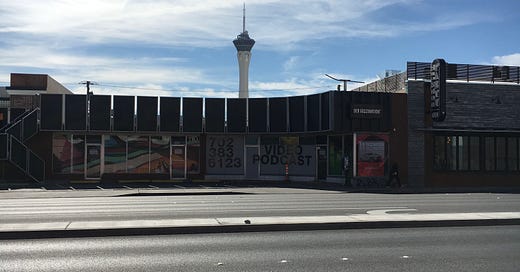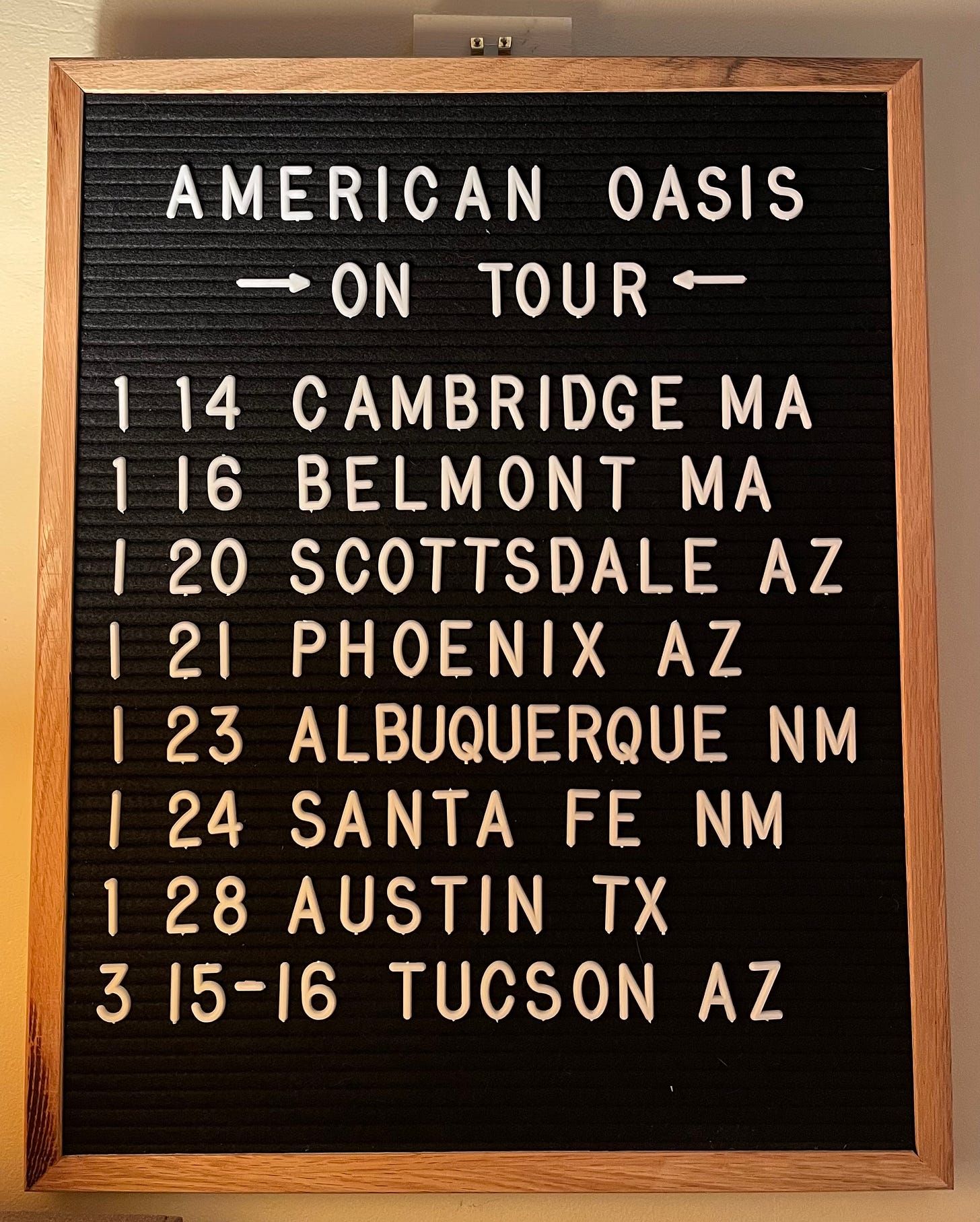3,2,1 — Let's Jam
Maryland Parkway, the Reptilian Lounge, and the struggle to build artist community in the desert.
In Las Vegas, the 1990s are remembered as the era when Sin City went “family friendly.” Excalibur and Treasure Island were developed as casinos with the aesthetics of a kid’s adventure story, while New York-New York opened with a roller coaster as its signature attraction. However craven, the strategy worked: over the course of the decade, Strip revenue more than doubled.
Elsewhere, a moodier urban transformation was underway as an organic creative community coalesced along Maryland Parkway, the traffic artery that hugs the east side of the UNLV campus. The scene was propelled by the student station KUNV 91.5, particularly the Rock Avenue show that broadcast underground punk and hardcore music to an audience of disaffected young Las Vegans. When the Record Exchange and Benway Bop! opened on Maryland, they became the only stores in town where KUNV’s audience could buy independent music. Both shops quickly evolved into all-purpose community spaces. In Parkway of Broken Dreams, PJ Perez’ documentary about the Maryland Parkway scene, Ronn Benway remembers, “People who I grew up with would walk in the record store and say, ‘This looks like your bedroom when you were seventeen.’ And I was like, ‘That’s what I want here!’ I want a living room, I want a couch in back, I want this to be a comfortable haven for kids who have nowhere to go, because I grew up as a kid who had nowhere to go.”
Over at Café Espresso Roma, readers at a weekly open-mic called Poetry Live went from addressing a scant audience to a room so full that people had to sit on the marble table-tops. Occasionally, musicians would play the open mic, too, and one of those sessions was where The Killers made their debut, a decade before “Mr. Brightside” went platinum. In one of the commercial spaces upstairs of Roma, the city’s first alternative newspaper, In Music, had an office; in another, a bar called the Sports Pub became a favored punk venue. Down the block, Café Copioh debuted a beloved local band called Someone while kids skateboarded in the parking lot. Up and down Maryland Parkway, there was suddenly that rarest of commodities in Vegas: something to do off the Strip.
Doug Jablin, the host of an experimental KUNV show he described as an “audio collage,” started an event series at Benway Bop! called Club Virtual. Poets from Roma were invited to read, while a “house band” performed in the background. After Club Virtual moved to the psychedelic Rainbow Café, Jablin set up racks of TVs playing test signals. “Yes, there was poetry,” remembered the writer Meagan Angus, “but there was so much more. There was, of course, ubiquitous bodypainting. Usually somebody was doing some kind of artwork on the walls. It was just such a wonderful and overwhelming mix of sights and sounds and smells.” One night when the scheduled readers showed up late, Jablin decided to walk around the audience with a microphone and interview people. “It was the idea of being creative on the spot — like, what am I going to do, right now?”
Albuquerque once had its own sort of Club Virtual: The Reptilian Lounge. The Lounge was started by Tricklock, an experimental theater company I got involved with as a teenager. Not long after Tricklock was founded in the early ‘90s, the Lounge became an irregular happening at their Nob Hill storefront on Washington Street, an “underground cabaret” that allowed the slam poets who otherwise congregated at Blue Dragon or Winning Coffee to test out new material, along with performing artists from q-Staff and whatever various weirdos from elsewhere happened to be drifting through town.
By the time I got looped into the Lounge in the mid 2000s, the original space had been demolished. Tricklock had taken up residency at UNM and the company’s signature event circulated between independent spaces near the university or downtown, like the Outpost and the Orpheum. A few traditions were maintained despite the Lounge’s peregrinations: random calls for a ten-second dance party, an alluring Target Girl who guests would pelt with change as a way to tip performers, frequent toasts that would be called for by the MC screaming “Sociable!” at the top of his lungs. The comedy duo Shenoah Allen and Mark Chavez were always received rapturously at the Lounge, as were the occasional belly dancers and burlesque acts. I got a particular thrill seeing one of my friends get a big ovation for a silks routine after she started training with the Wise Fool company up in Santa Fe.
Maryland Parkway didn’t last long. In 1997, KUNV canceled Rock Avenue and converted to an all jazz format. “It was devastating to the culture of Las Vegas,” Chad Simmons told PJ Perez. “No longer was there the ability to hear the individual voices — I don’t know that it became more corporate, but there wasn’t that platform anymore.” Benway Bop! closed, Café Rainbow closed, Roma closed — and then many of the people who had filled those spaces scattered. “For all that we were doing and being creative,” Sharim Johnson, the frontman of Someone, remembered, “All the time there were conversations, like, ‘I want to get out of Vegas. I want to get out of Vegas. I want to get out of Vegas.’ That was always an underlying theme, even though we were there, doing this thing. And I was definitely one of those people who was like, you know, I can’t stay here forever.” Both Johnson and Meagan Angus ended up in Seattle, while their friends headed for Portland and L.A.
Those who remained in Vegas gravitated downtown, where Enigma Café, on Fourth Street, became the new go-to. In 1998, a handful of shop owners in the post-industrial, eighteen-block wedge of the city that split Downtown from the Strip founded the 18b Las Vegas Arts District. A First Friday open gallery series was soon organized, and, over the next two decades, the area matured to the point of hosting boutique shops and trendy restaurants, while still remaining cheap enough for artists to afford studio space.On a visit to Vegas a few years ago, I stayed in an apartment on the second floor of a building on West Imperial Avenue. Though I didn’t check in until after midnight, the garage door of the studio directly below my unit was open and an artist was outside using a circular saw to rend some metal while his enormous black poodle relaxed in the parking lot, oblivious to the shower of orange sparks.
That Las Vegas’ scrappy arts community survived the deterioration of the Maryland Parkway scene is remarkable, particularly after the New York Times called the Arts District “The Least Vegas Neighborhood in Vegas” in a 2019 travel piece that namechecked the Cockroach Theater and a bar called the Velveteen Rabbit. Making the desert culturally vibrant is not easy — it requires near constant struggle, for resources and respect. There’s no guarantee that even the most successful institutions will last.
Tricklock survived for nearly three decades in Albuquerque until it was shuttered by the pandemic. But the Reptilian Lounge was resurrected a year later, when some of the old company members staged the event on Halloween amid the renewal of their annual international theater festival, Revolutions. Last year, the Lounge returned again for a one-night stand at the Box’s performance space on Gold Street. Making art in the desert can be an unforgiving business — it's far less lucrative than selling fantasy or rides on the Big Apple Coaster, and a multitude of young participants like myself are unlikely to stick around for long. Still, where there’s people, there’s creativity. Give a desert town enough time, and it will bloom — whether anyone elsewhere is paying attention or not.
This month, Sierra published my feature story on how Acadia National Park is both adapting to climate change and working to integrate the knowledge of the Wabanaki peoples into its management. This is a rare story that I was able to really take my time with and I have to say I’m quite thrilled with the result: it offers a snapshot of the National Park System at a precarious moment, as it seeks to shift away from the tourism-first mentality that characterized the agency for the past century while still accommodating the millions of people who mob parks like Acadia every summer. Here’s hoping that at least some of the reforms of the past few years survive the new Trump administration. Speaking of, I closed out December with one more article for Columbia Journalism Review, about how the new FCC director is likely to push the limits of the agency’s authority to regulate the broadcast media business. This is a case where the legal barriers of bureaucratic procedure may prevent much lasting damage, but it will still be up to media companies to stand strong against the coming fusillade. Though if ABC’s recent $15 million settlement with Trump is any guide, I’m afraid the latter part is not a bet I’d be willing to take.
On to 2025! With American Oasis due out in 15 days, I’m gearing up for a busy January. If you haven’t already, now’s a great time to preorder the book since it’ll start shipping out soon. I’ll be in touch with details about the book tour next week and am planning a special edition of this newsletter for launch day, but in the meantime here’s a brief rundown of the events we’ve confirmed so far:
Thanks, as always, for reading and subscribing. You can find me on my website, or contemplating how much green chile it’s advisable to pack into one’s body before a book reading.
Your pal,
Kyle





